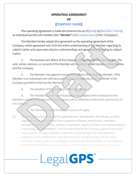What to Do When You Launch a New Digital Product
You’ve poured months into creating an online course, your first digital product, and you’re ready to share it with the world. But the to-do list is...
9 min read
LegalGPS : Jun. 12, 2025
Congratulations on launching your new website or app! After months of development, endless meetings, and late-night coding sessions, you've finally gone live. But contrary to what you might think, the launch is not the finish line—it's actually just the beginning of your digital journey.


Legal GPS Pro
Protect your business with our complete legal subscription service, designed by top startup attorneys.
The post-launch phase is critical to your long-term success. How you navigate the days and weeks after your launch can determine whether your website or app gains traction or fades into digital obscurity. This guide will walk you through essential post-launch activities to ensure your digital product thrives in today's competitive landscape.
Before diving into new tasks, take a moment to verify that all your pre-launch items were properly addressed. This quick review can catch overlooked elements that might impact performance.
Start by confirming that all pages are functioning correctly, links are working, forms are submitting properly, and payment systems (if applicable) are processing transactions. Check that your contact information is accurate and easily accessible.
Make sure your analytics tracking is properly set up. Without analytics, you'll be flying blind as you try to optimize your digital presence. Verify that Google Analytics (or your preferred analytics platform) is correctly installed and tracking user behavior.
A startup called DesignMate launched their new SaaS platform with great fanfare, but after three weeks, they couldn't understand why their marketing efforts weren't showing results in their analytics. Upon investigation, they discovered their developer had installed the tracking code on their main pages but forgot to add it to their sign-up flow pages. They had been missing crucial conversion data the entire time! A simple pre-launch checklist review would have caught this oversight.
Create a detailed spreadsheet with every critical technical element of your website or app. Include items like tracking codes, meta tags, mobile responsiveness, page speed scores, and security certificates. Check each item systematically within 24 hours of launch. This audit will serve as documentation for your current state and a reference for future optimizations.
With your checklist review complete, it's time to tackle crucial technical tasks that will set the foundation for your digital presence.
First, submit your website to search engines. While search engines will eventually discover your site, proactively submitting your URL through Google Search Console and Bing Webmaster Tools speeds up the indexing process.
Speaking of search console accounts, set these up immediately if you haven't already. These free tools provide invaluable insights into how search engines see your site and alert you to critical issues.
Conduct thorough cross-browser and cross-device testing. Your website may look perfect on your development environment but could have issues on different browsers or devices your users might use.
Check your site's loading speed using tools like Google PageSpeed Insights or GTmetrix. Loading time directly impacts user experience and search engine rankings.
Fashion retailer StyleHub launched their new e-commerce website after six months of development. Their desktop experience was flawless, but they soon discovered their mobile checkout process had a critical bug that prevented users from completing purchases on certain Android devices. This issue affected nearly 30% of their potential customers! After identifying the problem through post-launch testing, they fixed it and saw a 25% increase in mobile conversions overnight.
Don't wait for customers to tell you your site is down. Implement an automated uptime monitoring service like Pingdom or UptimeRobot that will alert you immediately if your website or app becomes unavailable. Many of these services offer free plans that check your site every few minutes and notify you via email or SMS if issues are detected.
With your technical foundation in place, it's time to focus on content—the lifeblood of your digital presence.
If you haven't already, develop a content calendar for the first three months post-launch. This calendar should include blog posts, videos, downloadable resources, and social media updates that provide value to your target audience.
Create and publish several pillar content pieces—comprehensive resources that demonstrate your expertise and provide significant value to users. These cornerstone pieces will serve as the foundation of your content ecosystem.
Establish a regular publishing schedule that your team can realistically maintain. Consistency matters more than frequency in building an audience.
Don't just create content—distribute it effectively. Identify channels where your target audience spends time and develop a systematic approach to sharing your content on those platforms.
SaaS company CloudTrack launched their project management platform with a modest blog featuring just five articles. Instead of trying to publish daily content, they committed to publishing one in-depth, research-backed article every two weeks. Each piece addressed a specific pain point for their target audience of product managers. By focusing on quality over quantity, they established themselves as thought leaders in their niche. Six months post-launch, their blog was generating 45% of their new trial sign-ups.
Create a systematic framework for distributing each piece of content across multiple channels. For every new piece of content, follow a predetermined process for sharing across social media, email, industry forums, and other relevant platforms. This matrix should include timing, messaging variations for different platforms, and a tracking mechanism to measure which distribution channels drive the most engagement.
To improve your website or app, you need to understand how users interact with it. Comprehensive monitoring systems give you the insights needed for data-driven decisions.
Implement user behavior tracking tools like Hotjar or FullStory that show heatmaps, session recordings, and user flows. These visual insights reveal how people actually use your digital product.
Set up custom event tracking in your analytics platform to monitor specific actions that matter to your business—like newsletter sign-ups, product views, or feature usage.

E-Commerce Terms and Conditions
Get our E-Commerce Terms and Conditions Template to define your sales terms and protect your online business legally.
Trusted by 1,000+ businesses to safeguard their LLCs.
Establish performance benchmarks and create dashboards that make it easy to spot trends or issues. Determine which metrics matter most to your business objectives and focus on those.
Don't forget to monitor your competitors. Tools like SimilarWeb or Ahrefs can provide insights into competitors' traffic sources, keywords, and content strategies.
Educational platform LearnQuest launched with a beautiful interface and comprehensive course offerings. Instead of just tracking page views, they created custom dashboards monitoring specific user journeys—from sign-up to course completion. They discovered that students were consistently abandoning courses at the third module. After investigating, they found these modules contained overly complicated assignments without enough preparation. By redesigning these modules, they increased course completion rates by 42%.
Don't wait for your weekly analytics review to discover problems. Set up custom alerts in Google Analytics or your monitoring tools to notify you immediately when important metrics deviate significantly from normal patterns. For example, create an alert for unusual drops in traffic, spikes in error rates, or significant changes in conversion rates. This proactive approach allows you to address issues before they significantly impact your business.
Your launch is a newsworthy event—make the most of it with strategic marketing efforts.
Develop a multi-phase social media announcement strategy that builds excitement over time rather than exhausting your message in a single post. Start with the announcement, then highlight specific features, share user testimonials, and offer exclusive launch promotions.


Legal GPS Pro
Protect your business with our complete legal subscription service, designed by top startup attorneys.
Create an email sequence for your existing contacts announcing the launch and highlighting different benefits in each message. Segment your audience to deliver the most relevant messages to different user groups.
Consider strategic paid advertising to amplify your organic efforts. Even a modest budget can significantly extend your reach when targeted effectively.
Don't overlook PR opportunities. Identify relevant industry publications, podcasts, and influencers who might be interested in covering your launch. Craft personalized pitches highlighting what makes your digital product newsworthy.
Fitness app MoveDaily didn't announce their launch with a single big splash. Instead, they created a three-phase launch campaign. First, they gave early access to fitness influencers who shared authentic experiences with their audiences. Next, they invited their email subscribers to join as founding members with special perks. Finally, they opened to the public with a launch event livestreamed on social media. This staggered approach created multiple waves of attention and resulted in 3x more first-week downloads than projected.
Prepare a comprehensive package of launch content that partners, influencers, and media can easily share. Include high-quality screenshots, promotional videos, pre-written social media posts, key messaging points, and founder quotes. Make it incredibly easy for others to help amplify your launch by providing everything they need in one organized package. This approach increases the likelihood of coverage and ensures consistent messaging across channels.
Your early users are invaluable sources of insights—establish systems to capture and act on their feedback.
Implement multiple feedback channels including in-app surveys, feedback forms, support tickets, and social media monitoring. Different users prefer different communication methods, so provide options.
Create a systematic process for categorizing feedback into bug reports, feature requests, UX improvements, and content suggestions. This organization helps prioritize responses.
Establish a quick response protocol for addressing critical issues. Users who provide feedback expect acknowledgment, even if you can't implement their suggestions immediately.
Look for patterns in feedback rather than reacting to every individual comment. Identify themes that represent opportunities for significant improvements.
When project management tool TaskFlow launched, they included a simple feedback button on every screen with the question, "How could this page be more helpful?" This unobtrusive method collected over 500 pieces of feedback in the first month. The development team categorized these insights and discovered that users were consistently confused by the terminology used in their reporting features. By simply renaming three key features to match users' natural language, they reduced support tickets by 40% and increased feature adoption by 25%.
Create a transparent, public-facing roadmap that shows users which improvements are planned, in progress, or recently completed. Tools like Trello, Notion, or dedicated roadmap software make this easy to maintain. This approach accomplishes three things: it shows users you're actively improving the product, manages expectations about upcoming features, and demonstrates that you're listening to feedback. Update this roadmap regularly and highlight when changes were inspired by user suggestions.
The first few weeks of analytics data provide a goldmine of optimization opportunities.
Focus on identifying drop-off points in your user journey. Which pages have high exit rates? Where are users abandoning forms or processes? These friction points represent your most important optimization opportunities.
Pay special attention to acquisition channels. Which sources are bringing the most engaged users? Double down on these effective channels rather than spreading your efforts too thin.
Implement A/B testing for critical pages and processes. Start with your highest-traffic or highest-value pages to generate meaningful data quickly.
Don't change everything at once. Methodical, incremental improvements allow you to clearly measure the impact of each change.
E-commerce site HomeStyles saw concerning trends in their first-week analytics. Their product pages had strong traffic, but very few visitors added items to their cart. By examining their analytics and heatmaps, they discovered that users were scrolling right past the "Add to Cart" button because it blended into the page design. A simple A/B test with a higher-contrast button color resulted in a 34% increase in add-to-cart actions. This single, data-driven change significantly improved their conversion funnel.
Establish a consistent weekly review of your key performance indicators. Create a standardized template that forces your team to identify: 1) What's working well that we should amplify? 2) What's not working that we should fix or eliminate? 3) What surprising patterns are emerging? and 4) What one optimization would have the biggest impact this week? This structured approach prevents analysis paralysis and ensures your team takes action based on data insights.
The launch version of your website or app is just the starting point. Planning your update cycle establishes momentum for continuous improvement.
Based on technical performance, user feedback, and analytics insights, create a prioritized list of enhancements for your first update. Balance fixing existing issues with adding new features.
Establish a realistic update frequency that your team can maintain. Whether it's weekly bug fixes, monthly feature updates, or quarterly major releases, consistency builds user trust.
Develop a communication strategy for updates. Users appreciate knowing what's changed and why. Consider release notes, blog posts, or in-app notifications to highlight improvements.
Create a beta testing program for significant new features. Engaging eager users in pre-release testing builds community and catches issues before widespread deployment.
When business messaging app ChatBiz launched, they committed to a transparent update process. They released small bug fixes weekly without fanfare but published detailed release notes for their monthly feature updates. These monthly releases became anticipated events, with users actively checking what new capabilities were added. By the six-month mark, ChatBiz had built such trust with their user base that when they needed to delay a major feature release, users were understanding rather than frustrated—all because of consistent, transparent communication about their update cycle.
Instead of tackling improvements randomly, organize your updates around specific themes. For example, dedicate one release cycle to performance optimization, another to user experience improvements, and another to new feature development. This focused approach makes your development more efficient, provides clear messaging for marketing, and helps users understand the value of each update. It also prevents the common pitfall of constantly chasing new features at the expense of improving existing functionality.
Launching your website or app is an achievement worth celebrating, but the real work of building a successful digital product has just begun. By systematically addressing the post-launch activities outlined in this guide, you'll create a strong foundation for long-term success.
Remember that the most successful digital products evolve based on user needs and behavior. The strategies you implement immediately after launch set the stage for continuous improvement. Stay attentive to user feedback, let data guide your decisions, and remain agile in your approach.
The digital landscape changes rapidly, but the principles of providing value, listening to users, and making data-driven improvements remain constant. Apply these principles consistently, and your new website or app will have the best possible chance of thriving in today's competitive digital environment.
The biggest question now is, "Do you need a lawyer for your business?” For most businesses and in most cases, you don't need a lawyer to start your business. Instead, many business owners rely on Legal GPS Pro to help with legal issues.
Legal GPS Pro is your All-In-One Legal Toolkit for Businesses. Developed by top startup attorneys, Pro gives you access to 100+ expertly crafted templates including operating agreements, NDAs, and service agreements, and an interactive platform. All designed to protect your company and set it up for lasting success.

Legal GPS Pro
Protect your business with our complete legal subscription service, designed by top startup attorneys.
|
Premium Template
Single-use Template |
Legal GPS Pro
Unlimited Access, Best Value |
|
|
| Choose Template | Learn More |
| Trusted by 1000+ businesses | |
Table of Contents

You’ve poured months into creating an online course, your first digital product, and you’re ready to share it with the world. But the to-do list is...

You’ve been selling handmade candles at local markets, and now you’re ready to take your side hustle online. The idea of reaching customers worldwide...

You’ve poured your heart into creating a unique brand name, logo, or slogan for your business. Then, you discover a competitor using a similar name,...